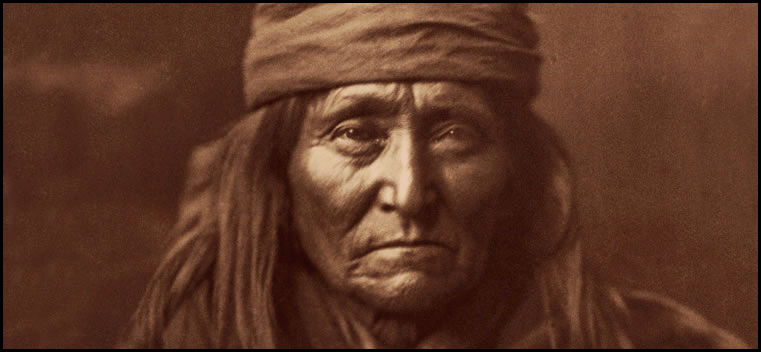An American Family Photo Album
Paisley Rekdal
(Tupelo)
Several of Curtis' most haunting photographs, each with a poem (presumably by Rekdal) on the essence, the context, or the meaning of the photo: "The heaviest exposures turn black to grey, a clay-like / mixture that muddies his looks."
Finally, there are snippets out of Curtis' life --- complaining letters from his wife, notes he has taken, details from his journey or, as we get closer to the end, notes from Curtis' journeyman assistant, Alexander Upshaw, his main translator.
Then there are stories out of Rekdal's own family: She as a child; her history-loving father; her Chinese mother.
This careful sequencing might sound boring, but it has its own natural rhythm, Intimate has its own winsome rhythm. We find ourselves wondering at Curtis' stubbornness --- Upshaw's, too (he was often living far from his wife and children, without enough food, comfort, and pay, often demanding to be allowed to leave; he never did).
We find ourselves getting involved with Rekdal's family, who may at first blush to have little or nothing to do with these characters from over a century ago as they traveled through the plains states and much of the upper northwest ... at times in grave danger, with equipment which weighed heavily on them: the fragile plates, the chemicals, the solvents. To do what they had to do, they would stop, get everything assembled, pose the pictures, take them, then dismantle everything and move on.
Eventually Curtis made over 40,000 plates. But, as we and Rekdal discover, he was somewhat eccentric. His travels over the vast west were endless, and endlessly draining. He had a solipsistic belief that he could record everything --- not only with photographs, but the 10,000 wax cylinder recordings of Indian lore and music.
Curtis was eventually to destroy much of what he had created. When his wife Clara divorced him, she got everything, we are told: the house in Seattle, the studio, all the plate glass negatives:
- Before turning the studio over to her, the photographer, his daughter Beth, and Upshaw will return to Seattle to print as many goldtones as they can, to copy some of the negatives out onto celluloid. Then they will take all the glass negatives across the street to the Cobb Building, pile them up and --- either out of love for them or a sense of duty --- smash them.
Curtis's story is something else again. Here is a man who talked J. Pierpont Morgan into supporting a massive series of volumes, twenty in all, with 1,500 goldpoint plates. He recorded lore on eighty tribes --- including Ojibwe, Diné, Hurok, Hopi, Crow, Apache, Oglala, and Apsaroke --- detailing food, clothing, beliefs, superstitions, ceremonies, funeral rites. But as Rekdal points out, he was not only trying to capture a way of life now doomed, he was besotted with nostalgia, ignoring that at all times we change: "I take out the mothers, the horses, the young boys collecting berries on the hillside, the land, the buffalo. I take out the clock and the camera, which takes out the future."
Rekdal has written her interpretation of Curtis' history. The inclusion of stories and events out of her own family might seem arrogant except that she has been captured by what we might identify as the Heisenberg factor. We look at photographs and not only are we changed, the photograph itself is changed. Rekdal is concerned with what photographs do to people, and the impact of the invention of photograph on the country and our country's history.
"During the same period when the camera become popular," she tells us, "the government completed its pacification of the Western tribes."
- The owners of the railroad lines, in conjunction with real estate developers, wanted people to see these lands as settled. They hired photographers to take advertising pictures of American Indians to entice travelers out into the countryside ... In this way, the camera helped invent tourism.
"In this way, as well the camera turned people into events, events into documents."
Rekdal injects herself and her family into this view of a certain specific phase of late 20th Century culture wars. We might ask what Curtis and Upshaw have to do with Rekdal, and with her mother and her father --- in, for instance, a hospital room filling out a doctor's questionnaire:
- We've got to fill this out, my mother says, handing me the doctor's questionnaire: Choosing Your End Quality of Life. Don't worry, she adds, noting my expression. It doesn't mean anything.
She hits the button on the side of her hospital bed to raise it. She smiles at me and my father. Let's spend a little quality time talking about death together, she says.
I open the questionnaire and begin reading. What do you define as basic quality of life?
Shopping and eating, my mother answers.
That's all you do now, my father mutters.
What measure, I ask, are you willing to take to preserve your life?
Don't keep me alive in a brain-dead coma, my mother says. Don't shock me with paddles. Tell them they can have all my organs but not my eyes.
Don't give me CPR: they'll crack my chest! my father adds. The doctor said you can be in pain for years after. And don't let them give me the expensive drugs. I'm not paying for any expensive drugs.
Give him the cheap ones, my mother agrees.
So what do you define as quality of life? I ask, turning to my father.
If I can read and look at your mother's stock reports, my father replies. Beyond that, kill me.
I shut the questionnaire. So essentially, I say, rubbing my temples, you both want to live exactly as you do now, or be dead. No middle ground.
My parents look at each other and think a little. They look back at me. Sounds good to us, says my mother.
